|
|
|
Sort Order |
|
|
|
Items / Page
|
|
|
|
|
|
|
| Srl | Item |
| 1 |
ID:
153437
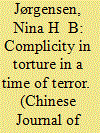

|
|
|
|
|
| Summary/Abstract |
This article examines how the European Court of Human Rights, in three “extraordinary rendition” cases – Al Nashiri, Husayn, and Nasr – has defined the responsibility of complicit States for torture as a human rights violation, seeking to determine the points at which the European Court's jurisprudence intersects with and diverges from other bodies of law, including the general law on State responsibility. Two issues that resonate outside the framework of the European Convention on Human Rights are discussed, namely the application of the subjective knowledge element in respect of the different forms of complicity, and the manner of addressing the role of States that may be considered primarily responsible for torture but that are not parties to the relevant proceedings.
|
|
|
|
|
|
|
|
|
|
|
|
|
|
|
|
| 2 |
ID:
128841


|
|
|
|
|
| Publication |
2014.
|
| Summary/Abstract |
Germany's highest court stopped short of ruling the European Central Bank's programme to support the euro illegal. Now the European Court of Justice must find a way to make the programme acceptable without making it ineffective.
|
|
|
|
|
|
|
|
|
|
|
|
|
|
|
|
| 3 |
ID:
085449
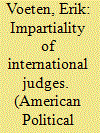

|
|
|
|
|
| Publication |
2008.
|
| Summary/Abstract |
Can international judges be relied upon to resolve disputes impartially? If not, what are the sources of their biases? Answers to these questions are critically important for the functioning of an emerging international judiciary, yet we know remarkably little about international judicial behavior. An analysis of a new dataset of dissents in the European Court of Human Rights (ECtHR) yields a mixed set of answers. On the bright side, there is no evidence that judges systematically employ cultural or geopolitical biases in their rulings. There is some evidence that career insecurities make judges more likely to favor their national government when it is a party to a dispute. Most strongly, the evidence suggests that international judges are policy seekers. Judges vary in their inclination to defer to member states in the implementation of human rights. Moreover, judges from former socialist countries are more likely to find violations against their own government and against other former socialist governments, suggesting that they are motivated by rectifying a particular set of injustices. I conclude that the overall picture is mostly positive for the possibility of impartial review of government behavior by judges on an international court. Like judges on domestic review courts, ECtHR judges are politically motivated actors in the sense that they have policy preferences on how to best apply abstract human rights in concrete cases, not in the sense that they are using their judicial power to settle geopolitical scores.
|
|
|
|
|
|
|
|
|
|
|
|
|
|
|
|
| 4 |
ID:
102581
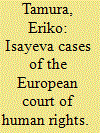

|
|
|
|
|
| Publication |
2011.
|
| Summary/Abstract |
This note analyses the 2005 Isayeva cases of the ECtHR, involving a non-international armed conflict, in order to show whether the Court applied only and directly the stricter standards of HRL (right to life in Article 2 of the ECHR) and, if not, how the Court substantially relied on IHL, by focusing on the differences of the principles of necessity and proportionality for the use of force between HRL and IHL. It concludes, contrary to what some authors insist, that even in the absence of the invocation of a public emergency in Article 15 of the ECHR by the State concerned, and therefore cautiously, the Court did indirectly apply IHL as an interpretive guideline for HRL.
|
|
|
|
|
|
|
|
|
|
|
|
|
|
|
|
| 5 |
ID:
085450


|
|
|
|
|
| Publication |
2008.
|
| Summary/Abstract |
The actual impact of judicial decisions often depends on the behavior of executive and legislative bodies that implement the rulings. Consequently, when a court hears a case involving the interests of those controlling the executive and legislative institutions, those interests can threaten to obstruct the court's intended outcome. In this paper, we evaluate whether and to what extent such constraints shape judicial rulings. Specifically, we examine how threats of noncompliance and legislative override influence decisions by the European Court of Justice (ECJ). Based on a statistical analysis of a novel dataset of ECJ rulings, we find that the preferences of member-state governments-whose interests are central to threats of noncompliance and override-have a systematic and substantively important impact on ECJ decisions
|
|
|
|
|
|
|
|
|
|
|
|
|
|
|
|
| 6 |
ID:
094975
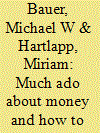

|
|
|
|
|
| Publication |
2010.
|
| Summary/Abstract |
This article analyses four decades of annulment cases against the European Commission brought before the European Court of Justice by dissatisfied Member States. Annulment cases are interpreted as incidents of a struggle between Member State governments and the Commission about policy decisions. Studying annulment cases for the first time in comparative perspective, three important patterns of variation are identified: with respect to the evolution of annulment cases over time, as regards the Member States as plaintiffs and in view of policy fields. Subsequently the data are interpreted on the basis of structure, agency and policy field specific explanatory mechanisms. Leaving the aggregate level, the two policy areas that account for more than 80 per cent of annulments are analysed: EU agriculture and competition policy. In the vast majority of cases, the dominant rationale behind annulments is not national objections to the supranational exercise of delegated powers per se or in specific policies (as most structural theories would expect) but to the way the Commission uses these competences to restrict how national governments may allocate European or national funding.
|
|
|
|
|
|
|
|
|
|
|
|
|
|
|
|
| 7 |
ID:
129464
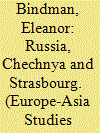

|
|
|
|
|
| Publication |
2013.
|
| Summary/Abstract |
This article explores contemporary Russian official and media discourse on cases concerning human rights violations in Chechnya which have been heard at the European Court of Human Rights. By comparing and contrasting the discourses on the Court's rulings which have been reproduced by various government representatives and various Russian newspapers, the article aims to demonstrate that, while official discourse remains critical of the Court's work with regard to Chechnya, reporting of such cases provides certain media outlets with the opportunity to criticise the government for its perceived failings in relation to safeguarding Chechnya's civilian population from human rights abuses.
|
|
|
|
|
|
|
|
|
|
|
|
|
|
|
|
| 8 |
ID:
133974


|
|
|
|
|
| Publication |
2014.
|
| Summary/Abstract |
This article explores the conceptual relationship between trafficking in human beings, enslavement and crimes against humanity. The analysis of case law of the International Criminal Tribunal for the Former Yugoslavia and the European Court on Human Rights reveals that, while trafficking in human beings and enslavement are increasingly overlapping, they still do not coincide. Moreover, enslavement is only a crime against humanity if it is committed in a widespread or systematic manner by an organization which displays State-like features. In the opinion of the author, the qualification of human trafficking as "modern slavery" is therefore confusing. The fact that human trafficking covers a wide array of offences influences the choice of forum in respect of criminal law enforcement. While enslavement as a crime against humanity may belong to the jurisdictional realm of international criminal tribunals and the International Criminal Court (provided that domestic jurisdictions have proved to be "unwilling" or "unable"), other forms of human trafficking are, in the view of the author, best left to national courts.
|
|
|
|
|
|
|
|
|
|
|
|
|
|
|
|
|
|
|
|
|